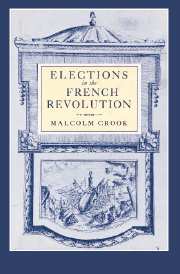Book contents
- Frontmatter
- Contents
- List of maps
- List of tables
- Acknowledgements
- List of abbreviations
- Introduction
- 1 Subjects to citizens? The elections to the Estates General and the Revolution
- 2 Limits of citizenship: The franchise question, 1789–1791
- 3 Biting on the ballot: From enthusiasm to abstention, 1790–1791
- 4 One man one vote? The experiment with electoral democracy in 1792
- 5 Voting the Constitution: The referenda of 1793 and 1795
- 6 Parties, schisms and purges: Elections under the Directory, 1795–1799
- 7 An invisible aristocracy? The departmental assemblies and the emergence of a new political class
- Conclusion
- Bibliography
- Index
4 - One man one vote? The experiment with electoral democracy in 1792
Published online by Cambridge University Press: 03 November 2009
- Frontmatter
- Contents
- List of maps
- List of tables
- Acknowledgements
- List of abbreviations
- Introduction
- 1 Subjects to citizens? The elections to the Estates General and the Revolution
- 2 Limits of citizenship: The franchise question, 1789–1791
- 3 Biting on the ballot: From enthusiasm to abstention, 1790–1791
- 4 One man one vote? The experiment with electoral democracy in 1792
- 5 Voting the Constitution: The referenda of 1793 and 1795
- 6 Parties, schisms and purges: Elections under the Directory, 1795–1799
- 7 An invisible aristocracy? The departmental assemblies and the emergence of a new political class
- Conclusion
- Bibliography
- Index
Summary
On 11 August 1792 fiscal restrictions on the franchise were swept away along with the Constitutional Monarchy in France. This ‘second revolution’, as historians have dubbed it, ushered in a phase of great political experimentation, yet where voting was concerned the changes were of limited scope and application. Since the celebrated Constitution of 1793 was not actually implemented the suffrage never became universal for adult males; some restrictions persisted and elections above the local level remained indirect. Nor was the renewed turbulence into which the Revolution plunged conducive to high turnout during this period. Nevertheless, two plebiscites or constitutional referenda aside, the primary and municipal elections held in the latter part of 1792 were the most democratic of the decade. Their conduct offers a number of vital insights into the more radical forms of electoral politics that revolutionaries had already been advocating via press and political clubs since 1789.
It was violence on the streets of Paris, not votes in the ballot box that brought down Louis XVI and the Constitution of 1791. Yet the importance attached to the electoral process was demonstrated by a general anxiety to legitimise the de facto Republic with the election of a new constituent assembly as quickly as possible.The day after the momentous events of 10 August 1792, the rump of 284 deputies, who remained on duty in a Legislative Assembly much-reduced by desertion and resignation, began to prepare for the convocation of a National Convention.
- Type
- Chapter
- Information
- Elections in the French RevolutionAn Apprenticeship in Democracy, 1789–1799, pp. 79 - 101Publisher: Cambridge University PressPrint publication year: 1996



